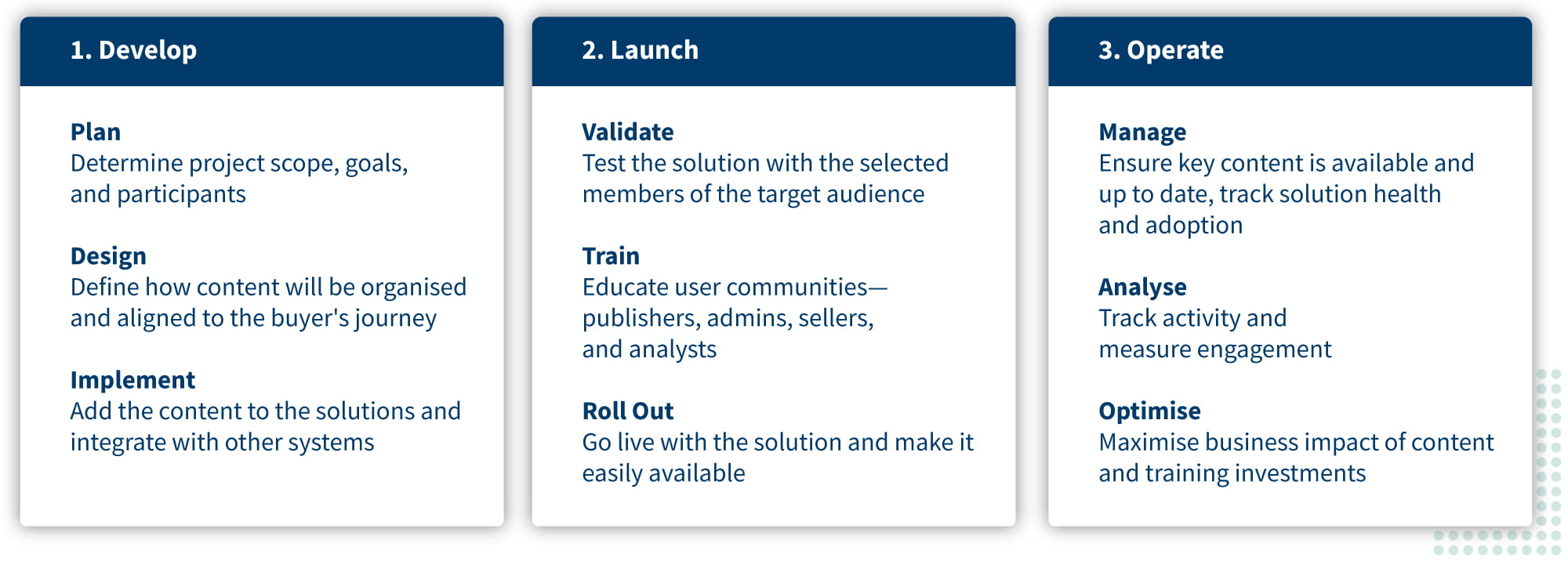Deployment Guide
Sales Enablement Deployment Guide
There is a tremendous amount of value that you can unlock through sales enablement. But it is important to keep in mind that you don’t have to “boil the ocean” right away. The most successful deployment projects that we have seen deliver value quickly by starting with the most painful problems that hold back your sales efforts. Once the system is up and working successfully, it is much easier to extend it into new areas and to support additional roles in the company.
Deployment Lifecycle
We have found it useful to break up the deployment into three phases.

Develop
During the develop phase, the project is planned, designed, and implemented. There are two common temptations that often cause problems during development.
Scope creep
It is very tempting to keep expanding the project as you go. While you build out the solution, you almost always discover new content that you hadn’t originally thought about, and new roles in the organisation that you could address if you add “just a little bit more” content.
Waiting for content initiatives
Virtually every company we have worked with had some set of initiatives underway to improve their existing content or develop some great new material that the sales team needs. “Maybe we should just wait until <content initiative> is done…then the content will be so much better!”
We strongly encourage companies not to wait and not to let the scope grow much beyond the original focus. There will always be active or contemplated initiatives to improve content. Those efforts are easier and much more likely to be effective with a solid platform in place. It is far easier to add content to a working and successful solution that is already deployed. Choose the most important content to focus on and get started with what you have. Most companies will use the process of collecting and organising their content as a good opportunity to do some clean-up and purging, which is a positive side effect of pulling it together. But try not to wait until some new class of content is developed — in our experience, that frequently takes much longer than anticipated.
Launch
The launch phase makes the solution available to the user community. In the enthusiasm to roll out a solution, companies frequently want to skimp on validation and training. This makes the solution less effective than it should be, and it hurts adoption. Often, the way that people in corporate headquarters think about organising information isn’t exactly the way that people in the field really use it. Getting experts in the target community as trial users will find those problems so they can be fixed before launch. And if people don’t get any training, adoption will be slowed down and users will take longer to become adept and efficient.
Operate
After launch, the company moves into the operate phase. By using the analytics system built into the platform, they can manage the content that is available on the platform and begin to move the company into a data-driven approach to optimising their sales cycle. We find that companies are most successful when they first use the platform to manage their content more effectively. Next they begin to analyse different areas of usage and performance. Then they optimise their content and their investments, using the insights from the analysis.
Building on Initial Success
As we have said above, we strongly recommend that companies start by focusing on the most important problem with the biggest business impact. For example, it is common for growing organisations to have a major content problem — sellers can’t find the content they need, and there is redundant and out-of-date material scattered across many locations. So the focus for the initial deployment might be the content that is needed by mainstream sellers to pitch and close new customers.
Once the basic solution is deployed and successfully addressing that most urgent need, it can be expanded to enhance the solution’s value:
More completely address the initial focus
Though the initial deployment should remain primarily focused on the most important content, the project team usually discovers additional resources as they build and operate the solution. After everything is up and running, the team can add additional information to make the system more complete. There are often specialised teams with unique content requirements, such as a subsidiary in another country or a team that targets a particular type of customer or partner.
Support additional needs of the current target audience
It is common for sales content to be the most urgent need, but not the only one. For example, the sellers might also need a structured onboarding and training programme. With a solution in place for sales content, the next step might be to tackle other needs for the users who are already on the system. The company might add training for new employees and training/certification programmes that any seller can use to enhance their skills and knowledge.
Expand to cover other teams
The company might also wish to address the needs of other customer-facing teams, such as account managers, consulting services, and customer success. Those teams typically use some of the material that is aimed at mainline sellers, but they also have other requirements that are specific to their role. They may also use different tools and services to manage their work, requiring additional integration.
Project Length
The time required to launch a solution depends heavily on the scope and on the amount of time that companies can dedicate to it. A simple rollout with basic content and a single sales team can be done in a few weeks. Deploying a solution for a multi-national enterprise with thousands of items and a heavily matrixed sales organisation is more likely to take a few months to complete.